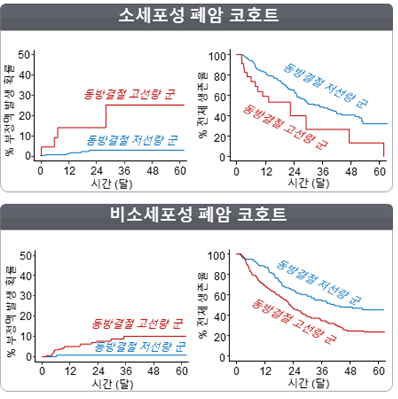글로벌 연구동향
방사선종양학
- [JAMA Oncol .] Association of Sinoatrial Node Radiation Dose With Atrial Fibrillation and Mortality in Patients With Lung Cancer폐암 환자에서 동방결절 방사선량과 심방세동 및 사망률의 연관성
연세의대 / 김경환, 오재원, 강석민*, 윤홍인*
- 출처
- JAMA Oncol .
- 등재일
- 2022 Nov 1
- 저널이슈번호
- 8(11):1624-1634. doi: 10.1001/jamaoncol.2022.4202.
- 내용
-
Abstract
Importance: Atrial fibrillation (AF) can develop following thoracic irradiation. However, the critical cardiac substructure responsible for AF has not been properly studied.Objective: To describe the incidence of AF in patients with lung cancer and determine predictive cardiac dosimetric parameters.
Design, setting, and participants: This retrospective cohort study was performed at a single referral center and included 239 patients diagnosed with limited-stage small cell lung cancer (SCLC) and 321 patients diagnosed with locally advanced non-small cell lung cancer (NSCLC) between August 2008 and December 2019 who were treated with definitive chemoradiotherapy.
Exposures: Radiation dose exposure to cardiac substructures, including the chambers, coronary arteries, and cardiac conduction nodes, were calculated for each patient.
Main outcomes and measures: Main outcomes were AF and overall survival.
Results: Of the 239 and 321 patients with SCLC and NSCLC, the median (IQR) age was 68 (60-73) years and 67 (61-75) years, and 207 (86.6%) and 261 (81.3%) were men, respectively. At a median (IQR) follow-up time of 32.7 (22.1-56.6) months, 9 and 17 patients experienced new-onset AF in the SCLC and NSCLC cohorts, respectively. The maximum dose delivered to the sinoatrial node (SAN Dmax) exhibited the highest predictive value for prediction of AF. A higher SAN Dmax significantly predicted an increased risk of AF in patients with SCLC (adjusted hazard ratio [aHR], 14.91; 95% CI, 4.00-55.56; P < .001) and NSCLC (aHR, 15.67; 95% CI, 2.08-118.20; P = .008). However, SAN Dmax was not associated with non-AF cardiac events. Increased SAN Dmax was significantly associated with poor overall survival in patients with SCLC (aHR, 2.68; 95% CI, 1.53-4.71; P < .001) and NSCLC (aHR, 1.97; 95% CI, 1.45-2.68; P < .001).
Conclusions and relevance: In this cohort study, results suggest that incidental irradiation of the SAN during chemoradiotherapy may be associated with the development of AF and increased mortality. This supports the need to minimize radiation dose exposure to the SAN during radiotherapy planning and to consider close follow-up for the early detection of AF in patients receiving thoracic irradiation.

소세포성 폐암 코호트(위 그림)에서 동방결절에 선량이 높은 경우 심방세동 발생이 25%로 선량이 낮았던 환자군(2.7%)에 비해 높게 나타났다. 비소세포성폐암 코호트에서도 역시 동방결절 선량이 높은 경우 심방세동 발생이 9.9%로 선량이 낮았던 환자군(0.7%)에 비해 높게 나타났다.
Affiliations
Kyung Hwan Kim 1, Jaewon Oh 2, Gowoon Yang 1, Joongyo Lee 1, Jihun Kim 1, Seo-Yeon Gwak 2, Iksung Cho 2, Seung Hyun Lee 3, Hwa Kyung Byun 1, Hyo-Kyoung Choi 4, Jinsung Kim 1, Jee Suk Chang 1, Seok-Min Kang 2, Hong In Yoon 1
1Department of Radiation Oncology, Yonsei Cancer Center, Heavy Ion Therapy Research Institute, Yonsei University College of Medicine, Seoul, Republic of Korea.
2Division of Cardiology, Department of Internal Medicine, Severance Cardiovascular Hospital, Cardiovascular Research Institute, Yonsei University College of Medicine, Seoul, Republic of Korea.
3Department of Biochemistry and Molecular Biology, Yonsei University College of Medicine, Seoul, Republic of Korea.
4Research Group of Healthcare, Korea Food Research Institute, Wanju-gun, Jeollabuk-do, Republic of Korea.
- 연구소개
- 국소진행성 비소세포성 폐암과 제한기 소세포성 폐암 환자는 항암치료를 위해 동시 항암화학 방사선치료를 받는다. 최근 방사선치료 기술의 발달과 항암화학요법, 면역치료 기술 등이 발전하면서 항암화학 방사선치료를 받는 환자들의 생존율 또한 비약적으로 증가하였다. 이에 따라 치료효과뿐만 아니라 장기적인 치료에 따른 부작용에 대한 관심도 높아졌다. 방사선치료는 많은 양의 방사선을 암 부위에 쏘아 종양을 줄이거나 없애는 치료 방법으로 방사선에 노출되는 부위에 부작용이 발생할 수 있다. 폐암의 경우 치료 중 방사선에 노출되는 심장에서 관상동맥질환, 심부전 등이 유발될 수 있는데 이에 관한 연구가 최근 활발히 이뤄지고 있다. 하지만 이중 가장 빈도가 높게 관찰되는 심방세동에 관한 연구는 그간 이뤄지지 않았다. 연구팀은 2008년부터 2019년까지 연세암병원에서 동시 항암 화학 방사선치료를 시행 받은 비소세포성 폐암 환자 321명과 소세포성 폐암 환자 239명, 총 560명을 대상으로 각 환자의 동방결절 선량을 CT상으로 측정해 심방세동 발생 빈도를 분석하였다. 분석 결과, 동방결절에 조사되는 선량이 높은 경우 선량이 낮았던 환자군과 비교해 심방세동 발생 위험도가 약 15배 높은 것으로 확인됐다. 소세포성 폐암 코호트에서 동방결절에 선량이 53.5Gy 이상 조사된 환자군에서 심방세동 발생이 25%, 선량이 낮았던 환자군에서는 2.7% 발생했다. 비소세포성 폐암 코호트에서는 동방결절에 선량이 20.0Gy 이상 조사된 환자군에서 심방세동 발생이 9.9%, 선량이 낮았던 환자군에서는 0.7% 발생했다. 특히, 동방결절에 조사된 선량이 높은 경우 3년 생존율이 약 20% 감소하는 것으로 나타났다. 반면 심방세동 외 다른 심장 부위의 부작용은 동방결절 선량과 무관했다. 본 연구는 심부전 발생의 위험인자인 심방세동이 동방결절 방사선 선량과 관련이 있다는 사실을 규명한 중요한 연구 성과라는 점에서 큰 의의가 있다. 또한 이번 연구 성과를 통해 방사선치료 가이드라인에 반영될 수 있는 동방결절 제한 선량에 대한 근거를 창출하였다. 더 나아가서, 연세의료원이 2023년 국내 최초로 시작하는 중입자치료를 통해 주변 정상 장기 선량을 감소시켜 폐암 환자의 정상 부위 부작용을 최소화할 수 있을 것으로 기대된다.
- 덧글달기










편집위원
폐암환자에서 cardiac substructures에 따라 선량인자 분석시 sinoatrial node의 Dmax와 atrail fibrillation과의 연관성을 보여준 흥미로운 연구입니다.
2023-01-06 14:52:31
편집위원2
폐암 방사선 치료에서의 심장 동방 결절부위 방사선량이 심방세동 부작용에 밀접한 관계가 있다는 것을 보여준 임상적으로 매우 유용한 연구라고 사료됩니다.
2023-01-06 15:05:28
편집위원3
폐암환자에서 방사선 치료 이후, 심장 동방 결절 부위의 심방세동 발생, 사망률의 연관관계를 분석한 흥미로운 논문임. 폐암환자에서 심방세동 증상의 경우, 심장 선량 평가 요인을 예측하고자 하는 흥미로운 연구 결과임.
2023-01-06 15:19:48